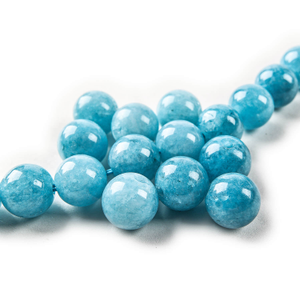- Jewelry-Making Supplies ▾
Design Jewelry with Confidence!
Seed Beads
Thread, Wire, & Stringing Materials
Athenacast Findings & Components
Everything Else
- Kits & Collections ▾
Assemble Your World
Kits & Collections
- Subscriptions ▾
Want monthly Beading Happiness?
Subscriptions
- Learn to Make ▾
Want to learn more?
- Discounts & Deals ▾
Explore Today's Promotions!
- Jewelry-Making Supplies
- Kits & Collections
- Subscriptions
- Learn to Make
- Discounts & Deals
-
Seed Beads
Thread, Wire, & Stringing Materials
Findings & Components
Everything Else
-
Kits & Collections
-
Subscriptions
- Home
- Beads
- Gemstone Beads
- Jade
ONLY VISIBLE ON EDIT MODE *
subtitle
page_content
videos
how to videos
Jade

Jade
History of Jade
Jade has been cherished across civilizations, most notably in ancient China and Mesoamerica, where it was more valued than gold. The stone was used in rituals, as part of burial ceremonies, and to craft objects of art and jewelry, symbolizing nobility and virtue. Jade comes in two primary types: Nephrite and Jadeite, with Jadeite being the rarer and more valuable of the two. Today, significant sources of Jade include Myanmar (for Jadeite) and China, Canada, and Russia (for Nephrite).
Color and Jewelry-Design with Jade Beads
The rich spectrum of Jade's colors provides a wide canvas for jewelry design:
- Classic green Jade pairs beautifully with gold settings, emphasizing its luxurious and timeless appeal.
- Lavender, red, and white Jade beads can be combined with silver for a more contemporary look.
- Mixing different colors of Jade within a piece can celebrate the stone’s diversity, creating visually captivating and harmonious designs.
Jade beads are perfect for crafting necklaces, bracelets, earrings, and rings that not only enchant with their beauty but also carry deep symbolic meaning, offering a connection to the ancient traditions that revered this stone.
Physical Properties
Jade is renowned for its toughness and resistance to breakage, making it an ideal choice for both ornamental and practical items. Its properties include:
- Hardness: Nephrite Jade has a Mohs hardness of about 6 to 6.5, while Jadeite ranges from about 6.5 to 7.
- Luster: Depending on its finish, Jade can have a smooth, waxy luster to a more polished, glassy appearance.
- Transparency: Jade can range from opaque to semi-transparent, with the most valuable pieces having a high degree of translucency.
Metaphysical Properties
Jade is attributed with numerous metaphysical properties, believed to:
- Foster wisdom, peace, and harmony.
- Attract good luck and friendship.
- Offer protection and ward off negative energies.
Healing Properties
Apart from its spiritual and emotional benefits, Jade is also thought to offer healing properties:
- Supporting the body's self-healing abilities, particularly with the kidneys and immune system.
- Calming the nervous system and promoting feelings of well-being.
- Detoxifying the body and balancing fluids.
Jade beads offer an exquisite opportunity for jewelry designers to create pieces that are not only visually stunning but also rich in history and meaning. The natural beauty and varied colors of Jade, combined with its deep cultural significance, make it a gemstone that resonates with many. By incorporating Jade into your designs, you can craft jewelry that not only adorns the body but also nurtures the soul, connecting the wearer to the ancient wisdom and protective energy of this cherished stone.
History of Jade
Jade has been cherished across civilizations, most notably in ancient China and Mesoamerica, where it was more valued than gold. The stone was used in rituals, as part of burial ceremonies, and to craft objects of art and jewelry, symbolizing nobility and virtue. Jade comes in two primary types: Nephrite and Jadeite, with Jadeite being the rarer and more valuable of the two. Today, significant sources of Jade include Myanmar (for Jadeite) and China, Canada, and Russia (for Nephrite).
Color and Jewelry-Design with Jade Beads
The rich spectrum of Jade's colors provides a wide canvas for jewelry design:
- Classic green Jade pairs beautifully with gold settings, emphasizing its luxurious and timeless appeal.
- Lavender, red, and white Jade beads can be combined with silver for a more contemporary look.
- Mixing different colors of Jade within a piece can celebrate the stone’s diversity, creating visually captivating and harmonious designs.
Jade beads are perfect for crafting necklaces, bracelets, earrings, and rings that not only enchant with their beauty but also carry deep symbolic meaning, offering a connection to the ancient traditions that revered this stone.
Physical Properties
Jade is renowned for its toughness and resistance to breakage, making it an ideal choice for both ornamental and practical items. Its properties include:
- Hardness: Nephrite Jade has a Mohs hardness of about 6 to 6.5, while Jadeite ranges from about 6.5 to 7.
- Luster: Depending on its finish, Jade can have a smooth, waxy luster to a more polished, glassy appearance.
- Transparency: Jade can range from opaque to semi-transparent, with the most valuable pieces having a high degree of translucency.
Metaphysical Properties
Jade is attributed with numerous metaphysical properties, believed to:
- Foster wisdom, peace, and harmony.
- Attract good luck and friendship.
- Offer protection and ward off negative energies.
Healing Properties
Apart from its spiritual and emotional benefits, Jade is also thought to offer healing properties:
- Supporting the body's self-healing abilities, particularly with the kidneys and immune system.
- Calming the nervous system and promoting feelings of well-being.
- Detoxifying the body and balancing fluids.
Jade beads offer an exquisite opportunity for jewelry designers to create pieces that are not only visually stunning but also rich in history and meaning. The natural beauty and varied colors of Jade, combined with its deep cultural significance, make it a gemstone that resonates with many. By incorporating Jade into your designs, you can craft jewelry that not only adorns the body but also nurtures the soul, connecting the wearer to the ancient wisdom and protective energy of this cherished stone.
Highest Quality
Products
100% Money
Back Guarantee
Fast
Shipping
Best Teaching &
Customer Service
You'll want these emails...
Get Free Projects & Inspiration
Get Free Projects & Inspiration
- Bullet 1
- Bullet 2
- Bullet 3
Copyright © PotomacBeads





